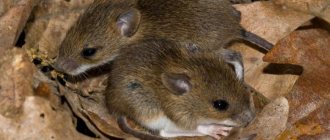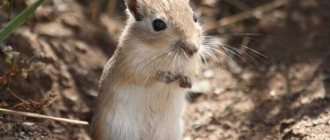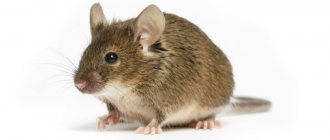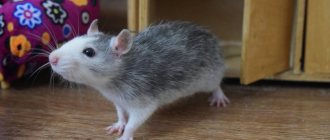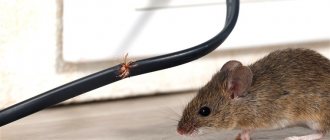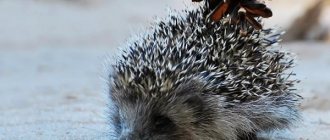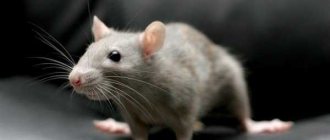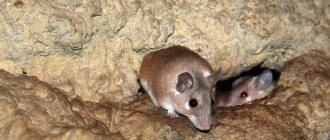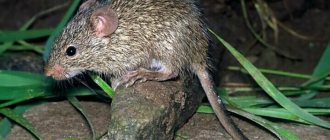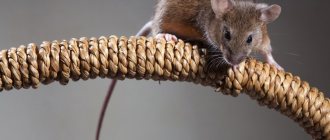Mice are rodents that do not suffer from lack of appetite and can cause enormous damage to food supplies. These animals are considered omnivores, but they have a keen sense of smell and will not try products that contain chemical additives.
And if you know what mice eat in the wild, many mistakes when forming the diet of a domestic decorative rodent can be avoided.
General characteristics of mice
These are the smallest representatives of the rodent genus. They are capable of growing up to 15 – 20 cm in height and weighing about 30 – 60 grams. They come in different colors, but only gray, white or brown. There are up to 50 shades of rodent fur. By the age of 6–8 weeks, the female becomes capable of childbearing. Capable of giving birth to 5 to 10 mice at a time.
For copulation, the female and male should be kept apart until the very moment of copulation. The lifespan of mice is 2 – 3 years. They are primarily herbivores, but are essentially omnivores. A small mouse sometimes eats meat, the corpses of relatives, and is capable of gnawing the tail of its neighbor out of hunger. Unlike guinea pigs, mice do not need fortified food at home.
What else can you supplement your diet with?
To prevent decorative mice from having problems with teeth grinding down, in addition to the main food, it is advisable for them to occasionally gnaw on pieces of spruce and pine needles, as well as tree branches:
- aspen;
- hazel;
- apple trees;
- and you;
- rowan.
The branches should be young and juicy, with high nutritional and taste properties.
It is advisable to supplement the diet of ornamental rodents with the following products:
- boiled meat (including well-processed spongy bones and cartilage);
- egg powder (or crushed boiled eggshells);
- milk and dairy products;
- cheese (in limited quantities);
- fresh lard;
- mineral additives (chalk, salt);
- fish oil;
- yeast;
- nuts (except peanuts).
Habitat of a small rodent
The distribution range of mice in natural conditions covers most climatic zones, continents and zones. Representatives of the family can be seen in deciduous and coniferous forests, in tropical thickets, in deserts and steppes, in swampy areas or on mountain slopes. But the most comfortable habitat is human dwellings.
Mice often make nests using grass stems, settle in burrows abandoned by other animals, or dig complex communications under the thickness of the earth. Mountain, forest and steppe varieties of rodents, unlike swamp ones, float rather poorly on water.
What do house mice like?
Rodents that live near humans have a unique appetite. These are animals that quickly get used to humans and are easy to train.
House mice love apples, melons and grapes. In addition, their diet may include greens, bread, dried fruits, cucumbers, zucchini, etc.
Some species of mice eat raw meat, including their smaller counterparts. Although it is believed that mice do not have cannibalism.
Features of behavior
It is interesting to observe the behavior of these rodents. They are smart, active, inquisitive, and capable of playing pranks. In the wild, each animal occupies its own territory. Males require more space. Sometimes they give the females a little space in their area. Males tend to defend their own territory from the encroachments of strangers. Females, if necessary, also rush into battle for a place to live.
Females are more friendly and sociable in captivity. They will not fight if there are several individuals living in a cage. If offspring appear at the same time, they raise them together, helping each other.
Sometimes female mice prefer to place newborn mice separately. Males should not be kept together - just like in the wild, everyone wants to have their own territory. Under natural conditions, they do not help mothers raise their offspring. While in captivity, the male is able to warm the babies with his body while the female rests or eats.
Ready-made feed
The simplest and least burdensome option for organizing the nutrition of any pets was and remains industrially produced food. There is one for mice too.
When choosing the right one, you always pay attention to both the manufacturer and the ingredients. Foreign products are still considered the best food for mice.
In any case, it is always necessary to carefully study the composition on the packaging and/or, if possible, try to visually determine the percentage of ingredients.
You should not purchase the following mixtures:
- with a high content of oats or grass granules,
- containing dyes,
- with a predominance of sunflower seeds, cumin or peanuts - these products should undoubtedly be included in the diet, but too much of them will lead to obesity,
- universal food for all types of rodents - nevertheless, the nutritional needs of all organisms, and even more so of representatives of different species, differ, and in some cases the difference is colossal.
Diet of mice in the wild
Remembering children's cartoons, many are sure that more than anything else, all mice love cheese. This is not entirely true, and in the wild their diet is completely different than in captivity. In their stashes it is possible to find such agricultural crops as wheat, rye, oats, grain, corn, barley, oats, sorghum, millet, and the fruits of various plants. Small mice feed on them in large quantities, causing irreparable damage to agriculture.
Since they reproduce quickly (each female gives birth 4 times a year), rodent control is quite difficult. Voles, steppe and meadow inhabitants happily feed on seeds of deciduous trees, nuts, mushrooms, and tops. If the reserves made in the autumn and spring are not enough to last the whole winter, mice find plant roots, nuts, mushrooms, and so on underground. In winter, without hibernating and being in a panic from lack of food, the mouse often even eats beetles, spiders, and worms.
Who eats mice
Voles are common on almost all continents, as well as the islands of the Northern Hemisphere. Most rodents inhabit regions with a temperate climate and open landscapes. Such places are rich in food: tubers and shoots of plants, grain crops, insects.
Due to their high fertility, mammals reproduce rapidly; in 1 year the population increases by several dozen times. The wide distribution of rodents makes them available food for predatory animals and birds.
Animals
In nature, mice feed on weasels, foxes, and martens, for which rodents are the main food. A ferret can eat up to 12 rodents per day. Weasels, which have a narrow, long body, often climb into holes and destroy mouse pups. If there is no large prey, mammals become food for arctic foxes, lynxes, wolves, and mongooses.
Voles are the favorite and, in winter, the only food of foxes. In cold weather, the size of the population of these animals directly depends on the number of mice eaten.
The natural enemies of wild mice are domestic and forest cats. For hedgehogs, voles are not daily food, since the animals are simply not able to catch them. But if a mouse gets in the way of a hedgehog, it will be eaten.
Birds
Another terrible enemy of rodents is birds of prey. One owl or owl can destroy about 1,200 individuals in a year. The special structure of the digestive system allows owls to eat voles completely, with hair and bones. Birds hunt at night and use the animals to feed their chicks. Sometimes mice become food for a shrike or raven.
Snakes, lizards
Mice become an important element of nutrition for snakes and vipers. They go hunting at night, catch voles, swallow them completely, and then digest them. Vipers often settle in underground burrows dug by rodents.
Some large lizards are not averse to eating mice.
Plants
For wild animals living in the tropics, there is another danger - the insectivorous plant Nepenthes spathulata. It is found on the islands of Sumatra and Java. The flower reaches 5 m in length and is considered a predator that lures small animals with its scent, swallows it, and then completely digests it with the help of digestive enzymes.
In appearance, the plant resembles water lilies hanging in a row on a stem. The inner surface of the flowers is smooth and slippery and emits a sweet smell that is attractive to animals. Mice and insects, getting inside, slide down the edge to the very bottom, then are digested over the course of several days.
What do rodents eat in captivity?
Living near humans, rodents eat any food. Most often these are fruits and vegetables, hard cheeses, milk, sugar, sausage, dried fish, bread. Among vegetables, the mouse willingly eats raw potatoes, carrots, and beets. House mice give birth to offspring up to 6 times a year. The litter contains about 10 mice, which by the age of 2 months are fully mature individuals. When rodents are hungry, they even feed on wood and paper, crushing them with their strong teeth.
If a mouse is kept in the house as a pet, it eats not only human food, but also the imported food offered to it. Such food does not contain husks or coarse grasses. They include nuts and seeds in a small percentage. Owners can provide their pets with a natural diet through seeds, cereals, protein products, vegetables and fruits, herbs, bread and cheese.
Types of mice and their food preferences
There are several types of mice in nature. Each of them has a slightly different diet. For example, the menu of steppe rodents is dominated by cereals and larvae of small insects, while that of meadow rodents is dominated by grasses, berries and root crops. Forest mice prefer mushrooms, acorns and tree bark. Rodents that live near bodies of water eat mainly spiders, caterpillars and plant roots. Another type of mouse is the taiga mouse. The basis of their diet is lingonberries and cranberries.
What do mice eat in nature and in the house? Who are their natural enemies?
Mice are small rodents with a pointed, elongated muzzle, large ears and round eyes.
A distinctive feature of these animals is a long, slightly drooping tail without hair. The mouse family includes about 400 species of animals. The body length of an adult is no more than 20 cm, weight is up to 50 g. Rodents are omnivorous, distributed everywhere except in the highlands and northern regions. Some people have warm feelings for them, so they have them at home. Let's take a closer look at what mice like to eat in different living conditions.
Care and maintenance of mice at home
The house where decorative mice live can be a cage, an aquarium, or a transparent plastic box. For a small number of animals, a dwelling measuring 25*45*22 cm is sufficient. The bottom of the terrarium is covered with sawdust from fruit trees or hygienic filling made from corn, paper, or straw. Decorative rodents need to change their bedding at least once a week, but preferably every 3 days. The top of the terrarium is covered with a lid with holes for oxygen.
Several shelters are equipped inside the house, preferably at different heights. All types of mice are very active and run up to 40 km a day in their natural environment, so the terrarium should have a running wheel. You can supply water to rodents through a hanging drinking bowl or pour it into a small saucer.
A decorative mouse is an animal that easily gets cold and overheats. It is better to place the animal’s house away from the window, protect the cage from drafts and bright sunlight. The ideal temperature for these rodents is 20-22⁰С.
Vole mouse and man
The confrontation between man and this small animal has continued for millennia. The vole mouse lives not only in fields, meadows, and forest areas, but also near people, where there is always something to profit from. At the same time, they cause great damage to food supplies and cultural plantings. It is also worth noting that mice pose a great danger to human health, since they are carriers of many diseases, including fatal ones.
Harm from the life of a vole
The damage is especially noticeable in years when they are favorable for the active reproduction of mice. As a result of the life activity of rodents, they suffer from:
- Underground parts of plants, causing the plants to die.
- Melons and root crops.
- Cereal grains and seeds of various plants.
- Aboveground parts of plants.
These rodents spoil farmers' plant products, which are in the field, as well as in storage facilities, elevators, warehouses, cellars, etc.
It is important to know! To understand that a vole mouse and its family have settled on the site, it is not at all difficult if you pay attention to the characteristic traces left by rodents after digging their burrows.
Disease carrier
This cute, at first glance, creature can pose a mortal threat to humans, since it can carry various infectious diseases. As a result of contact with this rodent, you can get sick:
- For typhus.
- For leptospirosis.
- For tularemia.
- For erysipelas infections.
- For toxoplasmosis.
- For salmonellosis, etc.
In the Transcaucasian region, these animals are the only natural carriers of such a dangerous disease as plague.
How to deal with a vole
Since rodents not only harm the future harvest, as well as the harvested crop, but also pose a direct danger to humans, we have to fight these rodents. You can use two effective methods:
- Scaring away animals.
- Direct destruction.
Repelling mice and voles
This method of control is considered more of a preventive measure, since it uses plants with a strong aroma that rodents do not like. The use of essential oils from similar plants, which have a more intense aroma, is considered more effective. To do this, pieces of cotton wool are taken and moistened in the essential oils of mint, calendula, wormwood, tansy and other plants, after which these pieces are laid out in places where rodents are expected to accumulate. Mice are afraid of spilled ash, as well as the odors of substances such as ammonia and kerosene. There is another effective way - the use of ultrasonic repellers or mechanical devices that produce noise and vibrations that are transmitted into the ground. Ultrasonic repellers can be bought in stores, and a mechanical device is easy to make yourself. To do this, take a stick or metal pin and insert it into the ground. A bottle (beer or plastic) is attached to the end of the stick so that it rotates in the presence of wind. When a beer bottle or can rotates, it creates a lot of noise, which is transmitted along the stick into the thickness of the earth. This creates a certain level of discomfort for the rodents, and they begin to look for more comfortable places.
A good option for dealing with mice is to have a cat, which is a natural enemy of rodents.
Physical destruction
The number of rodents is increasing at a rapid rate and, if nothing is done, they can easily devour the entire crop. When other methods of struggle do not give the desired effect, one has to resort to the last resort - physical destruction. In this case, you can use:
- A mixture based on gypsum . To do this, take gypsum or lime and mix it with sunflower or wheat flour. If a rodent tries such bait, it will soon die from a plaster blood clot in the stomach.
- Poisonous baits . You can buy ready-made, potent poisons in stores or on the market. The only problem is that they can be poisonous because they are not selective. If used incorrectly, you can cause serious harm to your health and your pets.
Important to remember! Poisonous baits are also dangerous because a cat or dog can eat a dead mouse. As a result, they may also die.
- Various traps . The use of various traps, especially in the plural, can stop the growth of the family to a controlled level.
- Mousetraps , which not only catch mice, but also immediately destroy them.
As bait, you can use both traditional cheese and other products in the form of nuts, smoked sausage, pieces of meat, bread, etc. The main thing is that the bait exudes a bright aroma, attracting rodents. It is quite natural that destroyed rodents will have to be disposed of.
How to get rid of mice in the garden and dacha. 100% getting rid of mice, rats and other rodents.
The role of voles in nature
Voles, like other species of rodents, play a very important role in maintaining the ecosystem of our Planet. Nature has thought out everything to the smallest detail. Since mice feed on the seeds of various grasses and plants, they limit the uncontrolled growth of green spaces. In addition, rodents are an integral part of the food chain of various birds and animals of prey. Under unfavorable conditions, when the number of rodents falls, the number of many birds and animals of prey also falls. If for some reason rodents disappear, then many birds and many animals will disappear, since they will have nothing to feed themselves and feed their offspring.
Despite the many varieties of these rodents, some species are protected as rare and endangered species. These types include:
- Evron vole.
- Muya vole.
- Balukhistan vole.
- Mexican vole.
- Japanese red vole.
- Taiwan vole.
- Central Kashmir vole.
Preventive measures
To reduce the likelihood of rodents appearing on your property significantly, sometimes it is enough to take a number of preventive measures.
As an option:
- You can get a cat or a dog.
- Do not expel natural enemies of rodents, such as owls, from the area.
- Do not allow various rubbish and debris to accumulate on the site.
- Till the soil to destroy field mouse burrows.
- Do not allow cut branches, leaves, weeds, etc. to linger on the site for a long time.
Good results can always be obtained if rodent control is carried out comprehensively, starting with preventative measures and ending with the physical destruction of pests, if other measures are ineffective.
Mice: benefits and harm
Species of wild rodents have long been considered enemies of humans. The field mouse damages grain crops. The house mouse contaminates food with feces and urine, and damages books, clothing, and home furnishings. Many types of mice carry infectious diseases: salmonellosis, hepatitis, encephalitis, toxoplasmosis, false tuberculosis and others.
But mice also bring significant benefits to people. Cosmetologists and doctors have been using mice for centuries to conduct all kinds of experiments. This is due to the extraordinary fertility of rodents and the similarity of the human and mouse genomes.
Zoologists raise special food mice for pythons, agamas, boas, geckos, snakes, ferrets, owls and cats. Sometimes decorative rodents are used for such purposes and sold to pet stores.
Peculiarities
Mice are small animals, the maximum body length of which (depending on the type of mouse) can reach up to 19 cm. These are very timid creatures, showing caution at every rustle and sound. Sensing danger, the animals quickly hide or start running. The language of communication for these small rodents is squeaking. They are able to live either alone or in a small family.
In autumn, the mouse tries to make supplies that it feeds on in winter. She lays them in nests that she makes from grass stems. Rodents also dig complex systems of underground passages and use abandoned holes to serve them as shelter.
What do mice eat? The animals have an excellent appetite. They love to feed on agricultural crops, which causes damage to the crop. But getting rid of rodents is not easy, since rodents reproduce very quickly: a female can give birth to up to 10 mice at a time. During the year, each female gives birth to 3-4 offspring. And given the fact that animals become sexually mature after 70-80 days and the female’s pregnancy lasts no more than 25 days, it becomes clear that mouse populations are replenished quite quickly.
On a note!
Under natural conditions, the animals live 9-10 months. The life expectancy of mice in captivity is much higher (up to 7-8 years).
Mice in history and culture
In ancient Greece, the white mouse was considered a sacred animal. Colonies of thousands of animals lived in the temples. They were heroes of legends and myths. They thought that the white mouse helped the oracles see the future, and the active reproduction of animals promised prosperity and a good harvest. The black mouse was considered a product of dirt and was subject to extermination.
In Japan they believed that a white mouse brings happiness. Seeing a place where a colony of rodents lives is a good sign, but a dead mouse meant grief. The Chinese considered this animal a symbol of wisdom and honesty. But among the ancient Persians and Egyptians, on the contrary, both the white and black mice were endowed with destructive, evil powers. They associated rodent invasions with the machinations of the terrible god Ahriman.
Cats appeared in the human home due to the dominance of harmful rodents. Even 6 thousand years ago, people began to feed wild cats, and they, in turn, began to protect their food supplies. But even now mice remain a favorite pastime for domestic cats. This long-standing enmity is the basis of many fairy tales, songs, cartoons, and proverbs. In the Internet era, special videos for cats have appeared. A mouse on the screen becomes a reason for a domestic cat to remember its hunting instincts.
What do mice eat?
Mice are small animals that number up to 400 species, and they differ in both appearance and living conditions. Representatives of this genus are found in almost all corners of our Planet. The most common species found on our territory are house mouse, field mouse and wood mouse. As a rule, they prefer to settle near human habitation, since in such conditions they always have something to profit from. These small animals are practically omnivorous and easily adapt to various, sometimes extreme, living conditions. Therefore, their diet is very extensive.
How mice behave in their natural environment
In order for rodents to maintain a constant body temperature, they need to be active in winter and summer, day and night. Gluttony and fussiness for mice are characteristic traits that help them survive and leave offspring.
In the fall, animals begin collecting provisions in a burrow or on the surface of the ground, where the “warehouse” is camouflaged with earth. And if in the off-season rodents are awake at night and sleep during the day, then in winter they remain active around the clock. In spring and autumn, when there is no shortage of food and no temperature fluctuations, mice actively reproduce.
Mice live in large families, since together it is easier for them to defend themselves, get food, build homes, and raise offspring. In a mouse pack there is a leader who maintains order in the group. Female mice are peaceful. But young males do not always put up with their subordinate position. Stomping with its hind legs and aggressive tail strikes indicate the animal’s intention to conquer the “throne.” Inter-family clashes can lead to the disintegration of the pack.
Harm from voles
Farms, summer cottages and various agricultural organizations bear the brunt of the damage. They are massively engaged in the production of fruits, vegetables and other things. These are the places where mice are found most often .
These little rodents' teeth grow throughout their short lives, so they have a constant need to chew on something to wear down their teeth. Because of this, they gnaw the bark of trees, their roots sticking out of the ground, after which the tree becomes sick and rots. If they get into the house, they can even chew through the boards in the floors and walls, turning your house or warehouse into Swiss cheese.
At home, mice eat everything that can get under their teeth - from fruits that have fallen on the ground to food in houses. Roots of plants, their stems, fruits from fruit trees, cultivated plantings - all this will be consumed by mice if they are not stopped.
Once in cellars or warehouses in winter, the mouse will eat everything there until spring, because it is very fertile for its short life.
Therefore, voles must be destroyed immediately as soon as their presence is noticed, otherwise the consequences can be dire.
